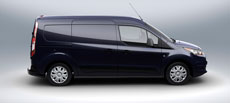Ford shifting to Transit van platform (with related video)

In a few years, the Ford Transit van will replace the Ford’s Econoline line as the vehicle of choice for ambulance operators, shuttle bus fleets and other commercial and public sector customers. Eventually, Ford may completely phase out the 50-year-old Econoline lineup.
Ford will migrate its commercial vans around the world to a common, global platform in 2013, when its Kansas City Assembly Plant workers begin producing the full-size Transit for North American customers. The shift to the Transit will likely lead to much lower production levels for Econoline cutaways, which are half-built vehicles that other companies turned into service vehicles such as ambulances and U-Haul trucks.
“There will be a transition period away from the Econoline,” said James D. Farley Jr., who is executive vice president of Global Marketing, Sales and Service and Lincoln at Ford. Speaking recently at a Detroit auto event where the Ford Transit was being showcased, Farley said: “The cutaway business is extremely important, and we want to maintain customer choice while we go through that process. But eventually, we want to be down to one commercial van.”
Farley explained that he has no idea how long that transition will take. If commercial customers take a liking to the European-designed Transit, it may only take a year or two. If customers continue ordering large numbers of E-Series cutaways (another name for the Econoline), Ford’s assembly plant in Avon Lake, Ohio, will continue building them for several years.
A version of the new Transit van, which is already available in Europe, will eventually replace the Econoline wagon and van in North America. The Transit will be a global cargo and people hauler, built on common platforms.
Ford’s 3.7-liter V-6 engine will be the base powerplant in the Transit van, and Ford will offer its 3.5-liter EcoBoost V-6, a turbocharged engine, as a premium offering for the Transit line. Ford also plans to offer a South African-built 3.2-liter diesel 5-cylinder engine on the van.
The Transit will achieve at least 25 percent better fuel economy compared to similar Econoline vans, thanks in part to weight savings that will trim at least 300 pounds from the vehicle compared to a similar E-Series van, according to Ford.
E-Series full-size vans and cutaways are available with optional flex fuel or CNG/LPG gaseous engine prep package fuel systems, or with a hybrid system from a Ford upfit partner.
The Transit Connect small van is available with either conventional, CNG or a battery electric drive system that’s capable of up to 80 miles of range with zero emissions. View another Govpro item on the Ford Transit here.
There are some alternative vehicles that can be outfitted as ambulances. They include the Chevy Express/GMC Savana 3500 series vans for Type II ambulance use. The second-generation Mercedes/Freightliner Sprinter van is growing in popularity with private ambulance operators, according to some motor vehicle blogs.
Watch a video of an old Econoline ambulance on a mission.




















